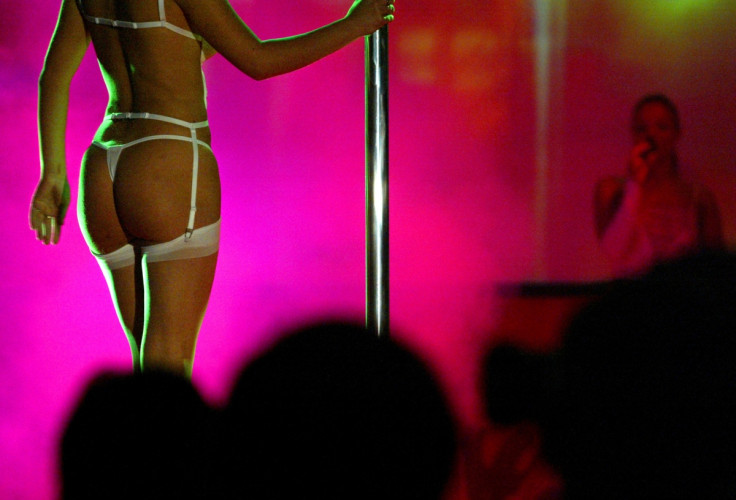Britain's lap dancing clubs must be shut down once and for all
There is an undeniable link between strip clubs and prostitution.

Could a ruling on criteria for licensing lap-dance clubs, delivered in the High Court on 8 May, be the beginning of the end for lap dance clubs in the UK? I certainly hope so.
Having spent time undercover (posing as a disgruntled secretary out with her boss) in several such clubs in Britain, I concluded that the ''services'' on offer – namely women stripping down to g-strings while performing private dances for leering men – is merely a form of prostitution.
My research into the link between lap-dance clubs and prostitution in London and Glasgow, published in 2004, found evidence in the clubs that the VIP suites, available for customers wishing to have ''one-to-one'' time with a dancer away from the public areas, are used as brothels. In the 13 years since my research was published, little appears to have changed.
When the licence for a Spearmint Rhino club in Sheffield was up for consideration last year there were 71 objections lodged, many of which focused on the impact of sexual entertainment venues on women.
The licence was renewed this April despite a further 97 objections from the public. The judicial review of the council decision was due to be held in court this week, but the claimant and Sheffield Council agreed to settle the case on the basis that it admitted it failed to prove it had met its duty to consider equality law.
The judge disregarded the argument put forward by Spearmint Rhino's lawyers that the objections were based on "prudish morality", and accepted it is an issue of women's equality, and of sexual objectification.
The case relied on the legal arguments put forward by campaign group Zero Option, and led by claimant Irene Gladisson, a lifelong Sheffield resident, who was concerned about negative impacts of the objectification of women.
Lap dance clubs promote and normalise naked women as a form of men's entertainment. But supporters of the clubs, which represent the interface between pornography and prostitution (dancers are photographed semi-naked and used to promote the clubs online and even on the sides of taxi cabs) argue that there is nothing wrong with men ''relaxing'' by having naked strangers displaying their genitals for money.
Gladisson says she knows of women who have stopped using facilities in the cultural industries quarter of Sheffield because of Spearmint Rhino. I don't blame them. My research found that three out of four people polled in both London and Glasgow said they did not want to live or work near a lap-dancing club, mainly because of drunken men fuelled by sexual excitement leaving the premises at all hours of the day and night.
A recent case in Doncaster, near to Sheffield, of a punter violently assaulting a dancer as she left the club for refusing sex, highlights the problem.
Lawyer Louise Whitfield, who represented Gladisson, says that the ruling is an important victory for those who are very concerned about the harmful impact of sex entertainment venues on women, and that the council now accepts that they were wrong to ignore the concerns raised about the sexual objectification of women, and to dismiss these as ''moral objections''.
The ruling will prove to be significant in the future, because from now, any local authority considering licence applications from sexual entertainment venues (SEVs) must look long and hard at any potential adverse impact on women's status.
I have met a number of women whose journey into prostitution began with being coerced into dancing in lap dance clubs. I have also witnessed women being trafficked from Albania into clubs in Italy in order to service punters in the so-called VIP suites. Women I have interviewed in brothels know fine well that lap-dance clubs are where sex buyers go to ''warm up'' before demanding sex. In the US, I have found such clubs attached to brothels, so that men can experience naked dancing as ''foreplay'' before popping next door for a quickie.
There are message boards used by male customers with threads dedicated to asking for tips on which clubs men can "get extras".
During my research I found that many lap dancers use drugs such as cocaine to stay awake, suffer from anorexia, and endure humiliating jibes and violent threats from customers. I also found that clubs regularly breach their own house rules, employment laws, and licensing conditions.
It was clear to me, after visiting six of the clubs, that many owners and managers create a context in which the buying and selling of sexual services would be likely to happen. Club owners tend to absolve themselves of any responsibility if sexual services are found to be on offer, or being arranged on the premises, yet at the same time the dancers are encouraged to project an air of sexual availability to customers.
Dancers are charged anything from £60 (in the seedier clubs on quiet nights) to £120 upwards (by the more lucrative clubs) for ''floor space'', which means that unless they are booked to do several private dances for customers (at around £20 a time) they may go home in debt.
The very existence of these venues promotes damaging views that women are sexually available to men and reinforces male sexual entitlement. I hope that every time a club applies for a licence in the future, the council is reminded of the ruling on gender inequality and refuses it.
Women cannot be equal in a world in which our breasts and genitals are viewed as entertainment for men.
© Copyright IBTimes 2025. All rights reserved.






















